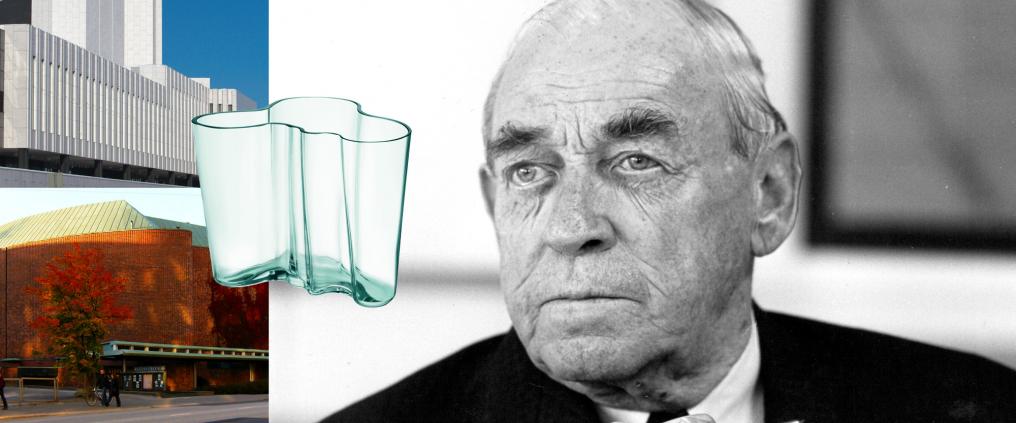Everyone in Finland knows the name the name Alvar Aalto (1898–1976). And abroad he is Finland's most famous Finnish architect and designer, one of the greatest names in modern architecture and a pioneer of Finnish functionalism.
Aalto has a secure place not only in the minds of Finns but also in their homes. Almost every Finn has sat on one of his three-legged birch stools, turned on a lamp designed by him, or set down a cup on the plywood serving cart with ceramic tile top, which he designed for the Paris World Fair in 1937. Many Finns still arrange cut flowers in Aalto vases, whose shape recalls the meandering shorelines of Finnish lakes. You can still find one in nearly every Finnish home and in dwellings all over the world.
The Aalto vase is one of the world's most famous glass objects – and is still produced by Iittala. It is for sale in shops at Helsinki Airport and is a popular souvenir.
Aalto is a part of Finnishness.
Aalto's minimalist style divides opinion, although, of course, for many in Finland he is nothing less than an undisputed icon. The man's face was proudly displayed on the 50-mark note before the advent of the euro – and ever more place names remind us of him. His lasting legacy, of course, resides in his buildings, which number about a dozen in Helsinki alone. Elsewhere in Finland and Europe, and even the United States, there are dozens more.
Nature and people
Aalto interpreted modernism whilst respecting the harmony that exists between nature, humans and buildings. An organic approach and the use of natural materials became evident in his work in the 1930s.
He paid close attention to landscape and topography, and tried to dissolve the boundary between the built environment and nature, and between interiors and outside areas, through the use of echelon formations, terraces, and vegetation and by providing buildings with panoramic views. His graceful shapes imitate nature, as does their location.
For Aalto a building was a complete work of art. He realised his ideal in, for example, the sanatorium in Paimio, every aspect of which he designed – right down to the door handles.
Success Aalto had a sense of responsibility, and he was optimistic and enthusiastic. He also believed in the 'new world' as represented by America and lamented the effects of the Second World War on Finland. He became involved in his country's reconstruction by developing quick-build prefabricated houses.
Despite their ambitious scope, his works could be playful and tantalising, manifested as bold experiment and historical references to ancient building traditions, for example. The master had a sense of humour: in the 1950s, at his career peak both at home and abroad, he named his motorboat 'Nemo propheta in patria' - 'No-one is a prophet in his own land.'
Alvar Aalto
- Qualifies as an architect from Helsinki University of Technology in 1921 and sets up shop in Jyväskylä in 1923.
- Chairman of the Association of Finnish Architects (1943–1958) and visiting professor at the Massachusetts Institute of Technology (1946–1948).
- Throughout his career, wins numerous architecture competitions.
- Receives the honorary title of Academician in Finland in 1955 and various awards, around the world.
Some of Aalto`s buildings in Finland
-
Espoo: Helsinki University of Technology (now part of Aalto University), Otaniemi
- Helsinki: • Academic Bookstore, Pohjoisesplanadi 39 • Finlandia Hall, Mannerheimintie 13 • House of Culture, Sturenkatu 4 • Rautatalo office building, Keskuskatu 3 • Stora Enso Head Offices, Kanavaranta 1 • Office building of the Helsinki City Electricity Company, Kampinkuja 2
- Lahti: Church of the Cross, Kirkkokatu 4 Vantaa: Aero Co. staff housing, Pyhtäänkorventie 23
Flying from Helsinki
- University of Jyväskylä (Jyväskylä, 45 minutes)
- Rovaniemi Administrative and Cultural Centre (Rovaniemi, 1 hour 20 minutes)^Seinäjoki Administrative and Cultural Centre (Seinäjoki, 1 hour)
- Tampella Co. Pekola Housing Area (Tampere, 35 minutes)
- Southwestern Finland Agricultural Cooperative Building (Turku, 35 minutes)
- Housing for Strömberg Co. (Vaasa, 1 hour), among others.
Source and further information: Alvar Aalto Foundation www.alvaraalto.fi, www.iittala.com, www.mfa.fi, www.rky.fi, Kansallisbibliografia, Wikipedia
Guide to Aalto buildings: www.alvaraalto.fi/aaltosites
Text: Terhi Kivikoski-Hannula
Photos: Lehtikuva
